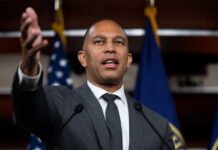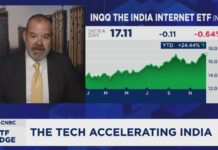Federal Reserve officials held off on cutting interest rates this week because they wanted to see a little more data to be sure that inflation is really coming under control. While that approach is cautious in terms of price increases, Friday's employment report underscored that it could be risky in terms of the labor market.
Unemployment rose to 4.3 percent in July from 4.1 percent after a sharp drop in hiring. The labor market declines have heightened concerns that the Fed has waited too long to cut interest rates – and that it may be falling behind, allowing a labor market slowdown that will be difficult to stop or reverse.
“They are absolutely behind and need to catch up,” says Julia Coronado, founder of MacroPolicy Perspectives.
High Fed interest rates help curb inflation by slowing demand. When it's more expensive to borrow money to buy a home or expand a business, people make fewer big purchases and businesses hire fewer workers. When economic activity declines, businesses find it difficult to raise prices as quickly, and inflation subsides.
However, this chain reaction can have serious consequences for the labor market. And once the labor market starts to weaken, the slowdown is difficult to stop: economists often say that the unemployment rate rises like a rocket and falls like a feather.
For months, Fed policymakers have been trying to balance two big risks. They are trying not to cut interest rates too early or too much, as that would allow the economy to rebound and leave inflation high. But as inflation eased and unemployment rose, Fed policymakers became increasingly aware of the second danger: that they could overdo it by keeping interest rates too high for too long. That could send the economy into such a slowdown that unemployment would rise sharply and many Americans would be out of work.
Fed Chairman Jerome H. Powell made clear this week that not cutting interest rates in July would be a difficult decision — and that Fed officials would be watching upcoming labor market data closely for signs that labor market conditions are deteriorating. He suggested that policymakers would be ready to respond if they saw signs that the labor market was suddenly and unexpectedly taking a turn for the worse.
“I do not want to see another significant slowdown in the labor market,” Powell said during his press conference following the Fed's July interest rate announcement.
Against this backdrop, Friday's slowdown in the labor market could further underpin the Fed's plans to cut interest rates at its next meeting on September 18.
It was not clear to what extent Fed officials would view Friday's report as evidence of a painful deterioration. Thomas Barkin, president of the Federal Reserve Bank of Richmond and in charge of monetary policy this year, stressed in an interview after the report's release that the Fed would release another jobs report – for August – before Fed officials would have to decide on their monetary policy response.
“The question with unemployment is: is it normalizing or is it heading for a dip?” Barkin said. “I think that's the question we need to look at more closely.”
In an interview with Sirius XM recorded Friday and scheduled to air in full on Monday, Austan Goolsbee, president of the Federal Reserve Bank of Chicago, sounded concerned about the report but also declined to comment on any one month's data.
“That's the number of a month, it's a negative number,” he said, later adding: “That negative number fits into the motto: Hey, you better be careful if you want to be as restrictive as we are.”
Wall Street traders seemed to believe that the weakening labor market could prompt the Fed to cut interest rates more sharply. After the report, the odds that the Fed would cut interest rates by half a percentage point at the September meeting, rather than the usual quarter-percentage point cut, rose significantly. (Economists often refer to these rate moves as 50 basis points and 25 basis points.)
“In hindsight, it's easy to say the Fed should have cut rates this week,” wrote Michael Feroli, chief U.S. economist at JP Morgan. “It's also easy to say they will cut rates soon.”
He predicted that the Fed would cut interest rates by half a percentage point in September and November. While that is more drastic than what some economists are calling for, the idea that central bankers would have to consider an even deeper rate cut quickly spread.
Blerina Uruci, chief U.S. economist at T. Rowe Price, said that “at this point, it looks like this is going to be a 25-50 decision for the Fed.” She added: “It would be aggressive to start the cutting cycle with such a big move – it would be a sign that they recognize they are behind.”
The Fed's decision on whether to take such a big step will depend on what happens with August's employment data, she said. If that report suggests July's weakness was overstated because of bad weather and other one-off trends, Fed officials may feel more comfortable cutting rates by only the normal amount.
“I have my doubts as to the extent to which the weakening is due to fundamentals,” said Ms. Uruci.
Barkin, for his part, seemed unwilling to accept the prospect of a massive rate cut. He said he would not “prejudge” the meetings, but also stressed that the labor market was cooling rather than collapsing. Although new hiring had fallen to 114,000, that was still a positive number.
“We need to look at the economic situation at the next meeting and the one after that,” he said. “Bigger cuts would normally be associated with an economy that feels like it is deteriorating rapidly. And again, 114,000 jobs is not as good as it has been, but it is a reasonable number in the long term.”
Nevertheless, the report is likely to give new impetus to Fed critics, who argue that monetary policymakers have been too slow in lowering interest rates given that inflation has been brought under control – thereby jeopardizing the health of the economy.
Politicians sometimes compare their approach to landing an airplane: they want to do it completely, but gently. But some economists fear Friday's report could be a sign that the landing will be harder and bumpier than hoped.
“I think when you're trying to land a plane, you want to get there before the alarms go off,” said Nick Bunker, North America economic research director at Indeed Hiring Lab. The Fed waited until it was confident enough that inflation was coming down before cutting rates, he said, but it may have bought that confidence at the expense of the labor market.
Some say that intervening too late could leave central bankers playing catch-up. While traders had previously expected the central bank to cut interest rates by three-quarters of a percentage point by the end of the year, the chances that it could cut rates by more than a full percentage point rose significantly on Friday.
That's because the Fed's current interest rate of 5.3 percent is well above the level that economists believe would weigh on the economy. That means the policy is effectively curbing consumer demand and hiring. To avoid a further slowdown in the labor market, interest rates may need to be cut significantly.
“You can’t maintain balance by magic – you have to move politics to achieve it,” Coronado said.














